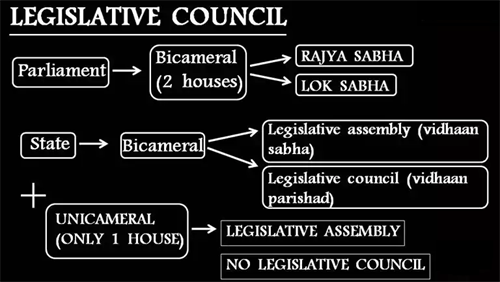PDF chapter test TRY NOW
In this module, let's learn in detail about the types of State legislature.
State legislature occupies a central position in the political system of a state.
First coming to the organisation of State legislature, most states follow Unicameral system (lower house alone ) while some states follow Bi-cameral legislature ( Upper and lower houses).
In India 6 states follow the bicameral system: Andhra Pradesh, Bihar, Karnataka, Maharashtra, Telangana and Uttar Pradesh, have bicameral Legislatures, the rest all have Unicameral Legislatures. The Jammu & Kashmir Legislative Council, the upper house of the Assembly was abolished recently, when the State was converted into an Union territory.

The Parliament can abolish a legislative council (where it already exists) or create it (where it does not exist).
The legislative council of Tamil Nadu had been abolished in 1986.
The legislative council of Tamil Nadu had been abolished in 1986.
For electing representatives to Parliament or State legislatures, elections must be conducted where people must vote to choose their representatives, for this purpose constituencies are created, explanation for this follows,
Territorial Constituencies : For the purpose of holding direct elections to the assembly, each state is divided into territorial constituencies. The demarcation of these constituencies is done in such a manner that the ratio between the population of each constituency and the number of seats allotted to it is the same throughout the state.
In other words, the Constitution ensures that there is uniformity of representation between different constituencies in the state.
Tamil Nadu Constituencies
Number of Assembly constituencies (MLA): 234
Number of Parliamentary Constituencies(MP): 39
Number of Parliamentary Constituencies(MP): 39
Reference:
https://www.civilsdaily.com/news/legislative-councils-and-its-abolition/
